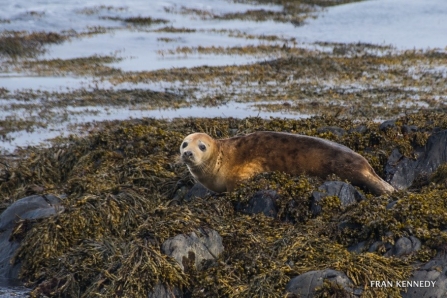Grey seals (Halichoerus grypus), are the larger of the two UK seal species. In fact, grey seals are the largest land breeding mammal in the United Kingdom, with males weighing up to 300kg. The grey seal can be distinguished from the UK’s other seal species, the common seal, by its larger size and longer head. If you can get a close up view you can spot further distinguishing characteristics, with the grey seal nostrils being parallel, rather than v-shaped as in common seals. This might be a clue as to how they got their scientific name Halichoerus grypus – meaning hook-nosed sea pig!
The UK population of grey seals dropped to only 500 individuals in the early 20th century, predominantly due to persecution. However, they’ve made a comeback with an estimated 120,000 grey seals now flourishing throughout the UK. This makes up 40% of the global population!
In Northern Ireland grey seal numbers are also flourishing. Grey seals around our coasts will spend most of their time at sea, in search of prey. Yet they come ashore in the autumn to form breeding colonies on rocky shores, beaches and on small largely uninhabited islands. For example in Strangford Lough, where a record number of grey seals were recorded during the breeding season in 2019.
Top sights to see grey seals around our shores include:
-
Strangford Lough
-
Cloghy Rocks, Ards peninsula
-
Rathlin Island
-
Copeland Islands
So what do our seals get up to day-to-day? These mammals spend most of their time out at sea hunting alone and being opportunistic feeders eating mainly sand eels, cod, flatfish, crabs and even octopus. Grey seals can dive to depths of around 70 metres when searching for food, with their large eyes allowing them to see well in dark waters and their highly sensitive ears being important for locating prey.


